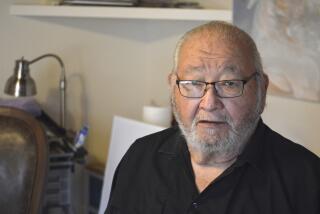University’s Tribute to Hemingway : Cultural Complex at Boise State Bears Name of Author
- Share via
BOISE, Ida. — Boise State University has established a literary and cultural complex bearing the name of Ernest Hemingway, who spent his final years in Idaho.
The Ernest Hemingway Western Studies Center, honoring “the most famous author ever to reside in Idaho,” was dedicated Oct. 24 on the Boise State campus. The ceremony culminated a year of special events at the school during which Hemingway’s life and works were explored through symposiums and films based on his writings.
Last year marked the 25th anniversary of the writer’s death. He died July 2, 1961 in Ketchum, Ida., 150 miles east of here, where he is buried.
“Ernest Hemingway found Idaho, after searching the world, to be a place where civilization and wilderness might coexist, a place to better face himself,” said Boise State University President John H. Keiser at the dedication. “What he wrote was sometimes tough, even crude, but so was the West, and his work was as deep and as pure as a forest or a trout stream. This center is meant to encourage dreams, stimulate questions, perpetuate memories and the spirit of adventure.”
It was the spirit of adventure and Idaho’s rugged wilderness that brought Nell Shipman to Priest Lake in 1922. Shipman was a silent film writer, director, producer and star. Her 1919 full-length feature, “Back to God’s Country,” filmed in Canada and on California’s Kern River, was a smash hit.
During her three years in Idaho, at Lionhead Lodge Studio on Priest Lake, she made another full-length feature, “The Grub Stake,” and five two-reelers, “White Water,” “Wolf’s Brush,” “Trail of the North Wind,” “The Light on Lookout” and “The Love Tree.”
Shipman’s film career ended when talkies came along. However, she wrote the screenplay for “Wings in the Dark,” starring Cary Grant and Myrna Loy, and later published several novels.
Valentine’s Day, Feb. 14, will be Nell Shipman Day on the Boise State University campus. Her autobiography covering the years from her birth in 1892 in Victoria, B.C., to 1925 will also be released that day by Ernest Hemingway Western Studies Series, the university’s newest publishing entity. Also scheduled Feb. 14 at the Hemingway Western Studies Center is a symposium on Shipman’s life and works. Her 25-minute two-reeler--”A Bear, a Boy and a Dog”--filmed on Mt. Washington in Los Angeles, will be screened.
Her son Barry Shipman, 74, a screenwriter who lives in San Bernardino, Calif., has written an afterword to his mother’s autobiography, “The Silent Screen and My Talking Heart.” She was 78 and living in Cabazon, Calif., when she died in 1970.
Nell Shipman’s autobiography is the third book issued by the Ernest Hemingway Western Studies Series. The first was James H. Maguire’s “The Literature of Idaho: An Anthology,” the first comprehensive compendium on the subject. Next came Mark Plew’s “An Introduction to the Archeology of Southern Idaho.”
Tom Trusky, 42, a BSU English professor, heads up the Nell Shipman project. Trusky has edited the university’s award-winning literary magazine, cold-drill, since its inception in 1970.
The magazine--published in a loose-leaf format--gets its name from the mining tool used to dig out rich veins of ore that are inaccessible using conventional modes of excavation.
Each year since 1975 Trusky has selected nine short poems written by BSU students and Western poets and reprinted them on colorful posters called Poetry in Public Places.
“The purpose of PIPP is to bring poetry to the people,” Trusky said. The posters appear on walls throughout Boise--in libraries, corporate headquarters and schools.
What was once BSU’s red brick Music Building has undergone a major renovation and is now the Ernest Hemingway Western Studies Center, housing all campus publishing activities as well as the headquarters for the Rocky Mountain Review (publication of the Rocky Mountain Modern Language Assn.), the Idaho Archeologist (publication of the Idaho Archeological Society) and the BSU Archeological Reports.
Jim Baker, 37, director of the Hemingway Western Studies Center, said it is an interdisciplinary facility whose resources are used by students of the arts and humanities, music, theater arts, English, literature, history and archeology.
More to Read
Sign up for our Book Club newsletter
Get the latest news, events and more from the Los Angeles Times Book Club, and help us get L.A. reading and talking.
You may occasionally receive promotional content from the Los Angeles Times.








